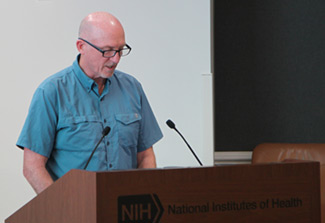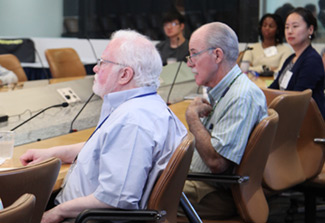Malaria network aims to boost collaboration, knowledge-sharing across U.S. government
August 19, 2024
By Judy Coan-Stevens
 Fogarty International CenterPatrick Duffy opened the inaugural meeting of the Federal Malaria Research Network.
Fogarty International CenterPatrick Duffy opened the inaugural meeting of the Federal Malaria Research Network.
On June 18, 2024, researchers from across the U.S. government convened for the inaugural meeting of the Federal Malaria Research Network (FMRN). Co-founded by scientists from the National Institutes of Health (NIH) and the Food and Drug Administration (FDA), the network brings together representatives from various U.S.-led malaria efforts. The U.S. government is the single biggest investor in malaria control and prevention in the world. Getting a handle on all that is being done—from basic research in vector biology to malaria vaccine development and anti-vector implementation programs— is no small task. FMRN allows those working in programs across the entire U.S. government to see where investments are being made and how they intersect, leading to collaboration, knowledge-sharing, and amplification of each other's work.
“We can be good spokespersons for the activities of our sister agencies that are doing amazing work," said Dr. Patrick Duffy, chief of the
Laboratory of Malaria Immunology and Vaccinology at the National Institute of Allergy and Infectious Diseases, and one of the networks' cofounders. “We can also learn where there are gaps and successes, and how things fit together." A lot happens between the “upstream" basic research and the “downstream" implementation of malaria control and prevention. By sharing across the entire spectrum, researchers can make connections to their current and future work. If something is not relevant now, “it might be relevant to what's needed in future for malaria control and prevention," added Duffy.
 Fogarty International CenterPeter Kilmarx (second from left) was among the experts who attended the meeting.
Fogarty International CenterPeter Kilmarx (second from left) was among the experts who attended the meeting.
With a remit to enhance cross-governmental strategic collaborations and activities to advance global malaria control and elimination efforts, FMRN plans to convene regularly to share ideas, expertise, and findings pertinent to use-inspired malaria research (research meant for real-world application), from laboratory to field investigations and implementation and impact evaluation. Areas of discussion will focus on novel detection technologies and strategies, vaccines and other preventive and therapeutic interventions, including malaria parasite vector control, as well as novel approaches to clinical trial design and monitoring of programmatic impact on malaria morbidity and mortality.
To kick off the information sharing, Dr. Rose Zulliger, senior malaria technical advisor at the
President's Malaria Initiative (PMI), presented an overview of PMI from its founding to its current structure. In addition to highlighting some of the initiative's successes and challenges, she outlined important threats to the fight against malaria that all researchers should be aware of. This includes partial artemisinin resistance—a delay in the clearance of malaria parasites from the bloodstream following treatment with an artemisinin-based combination therapy—the current standard of care for the disease; the lack of certain genes in
Plasmodium falciparum (the parasite that causes malaria), which compromises the effectiveness of some rapid diagnostic tests for malaria; insecticide resistance; and the spread
Anopheles stephensi mosquito—a species of mosquito originally from Asia that has spread to Africa and seems to thrive in urban areas. (The primary vector in Africa, the
A.gambiae mosquito, is mostly confined to rural areas.)
FMRN has been inspired in part by a previous entity called the Federal Malaria Vaccine Coordinating Committee. That committee was very focused on vaccine development, while FMRN has a wide interest in the range of issues, interventions and tools relevant to malaria control and prevention. “The genesis of this newer entity, rather than trying to coordinate activities, is to see more broadly across the whole U.S. government malaria effort," said Duffy, and to “make sure that we're not working at cross-purposes." One goal is that, with this network, researchers can speak knowledgeably about the malaria-based work that different U.S. government groups, such as USAID, PMI, CDC and NIH, are doing in a given country or region.
A broader goal is for those working within U.S. government agencies to gain more knowledge about the overall U.S. malaria footprint. “That knowledge can help us get the best return –on investment with the research that we're doing," said Duffy. “It's really helpful for us to see how we can best direct our resources to near-term needs as well as to future long-term solutions."
More Information
Updated August 20, 2024
To view Adobe PDF files,
download current, free accessible plug-ins from Adobe's website.
Related Global Health Research Topics